Discover the Top 6 Most Popular Monstera Plants for Your Home
Jess is a true horticulturist whose passion for plants has led her to become an expert in tropical houseplants. Jess was born and raised in...
Monstera plants, also known as Swiss Cheese plants, are popular for indoor gardening. Their large leaves and distinct fenestrations bring a touch of tropical beauty to any home.
This article will take a closer look at six of the most common types of Monstera plants for the home, including the Monstera deliciosa, adansonii, and more. We will cover everything from propagation and care to each plant's unique characteristics.
Whether you're a seasoned plant enthusiast or just starting indoor gardening, this guide will give you all the information you need to bring a piece of the tropics into your home.
Opinion
As you look through the various types of Monstera varieties available, you will notice considerable similarities between some. This is because several are subspecies of Monstera Deliciosa.
The problem arises in identifying specific species, especially when young as distinguishing features appear as the plant ages. This results in people buying what they think is one type of Monstera and actually getting a different variety. In truth, many of that selling don't really know what they have and often price at the variety that commands the best money.
If possible, you need to go to a trusted source to purchase and identify the host plant from which the cutting propagated came.
#1 Monstera Deliciosa
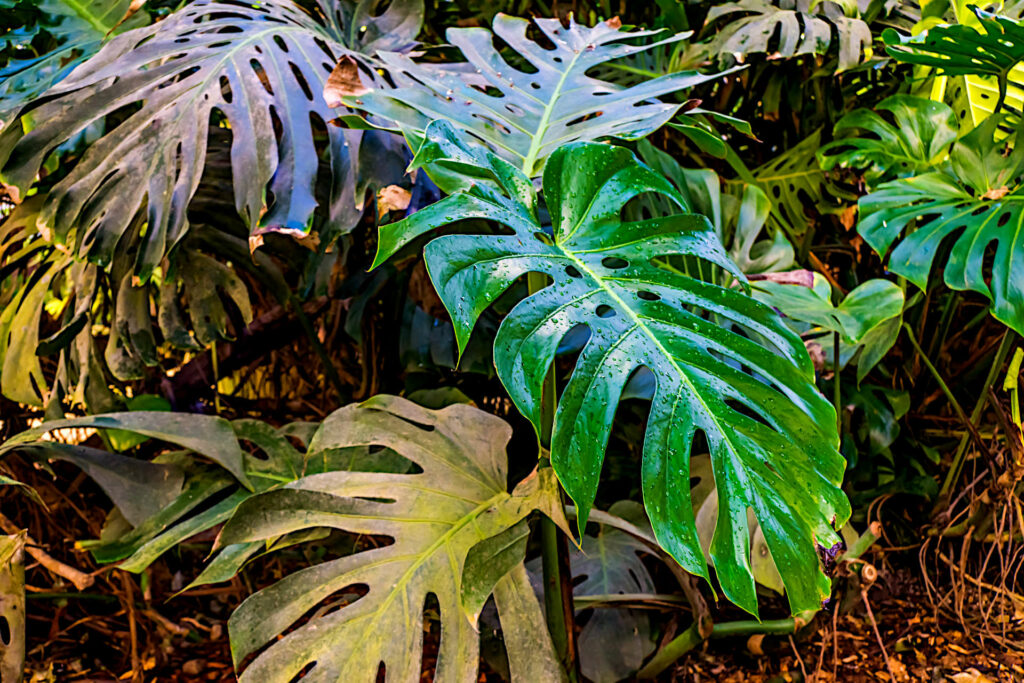
Monstera Deliciosa, also known as the Swiss Cheese Plant, is a tropical plant known for its large leaves and distinctive holes, or fenestrations, giving it a unique and striking appearance. In its native habitat, it can grow up to 30 feet tall, but as a houseplant, it typically stays much more diminutive. Despite its tropical appearance, it is relatively easy to care for and can thrive in a variety of light conditions.
Propagating Monstera Deliciosa
One of the great things about the Monstera deliciosa is that it can be easily propagated by taking stem cuttings and rooting them in water or soil. This allows you to create new plants from existing ones, which can be a great way to expand your collection or share it with friends and family.
To propagate Monstera deliciosa, take a stem cutting that includes at least one leaf node (the point on the stem where leaves grow) and a small section of stem. Remove any leaves from the bottom half of the cutting and place them in a jar or vase of water, ensuring that the leaf node is submerged. Alternatively, you can set the cutting in a pot of soil and keep it moist until roots begin to form. Within a few weeks, roots will start to grow, and new leaves will develop, indicating that the cutting has rooted and is ready to be transplanted into a larger pot.
Monstera Deliciosa's Versatility
Another benefit of Monstera deliciosa is its versatility. It can be grown as a climbing vine or trained to grow as a bush, making it a perfect option for various spaces. Whether you have a small apartment or a large house, this plant can fit in and add a touch of tropical beauty to your home. Additionally, its ability to adapt to different lighting conditions makes it an excellent option for rooms with varying levels of natural light.
There is no doubt that the Monstera deliciosa is a visually spectacular plant, easy-to-care-for, and versatile houseplant that can add a touch of tropical beauty to any room. Its ability to adapt to different lighting conditions and its ease of propagation makes it a good option for both experienced and inexperienced plant owners. Whether you're looking to create a focal point in a room or add some greenery to a space, Monstera deliciosa is sure to make a statement.
#2 Monstera Albo
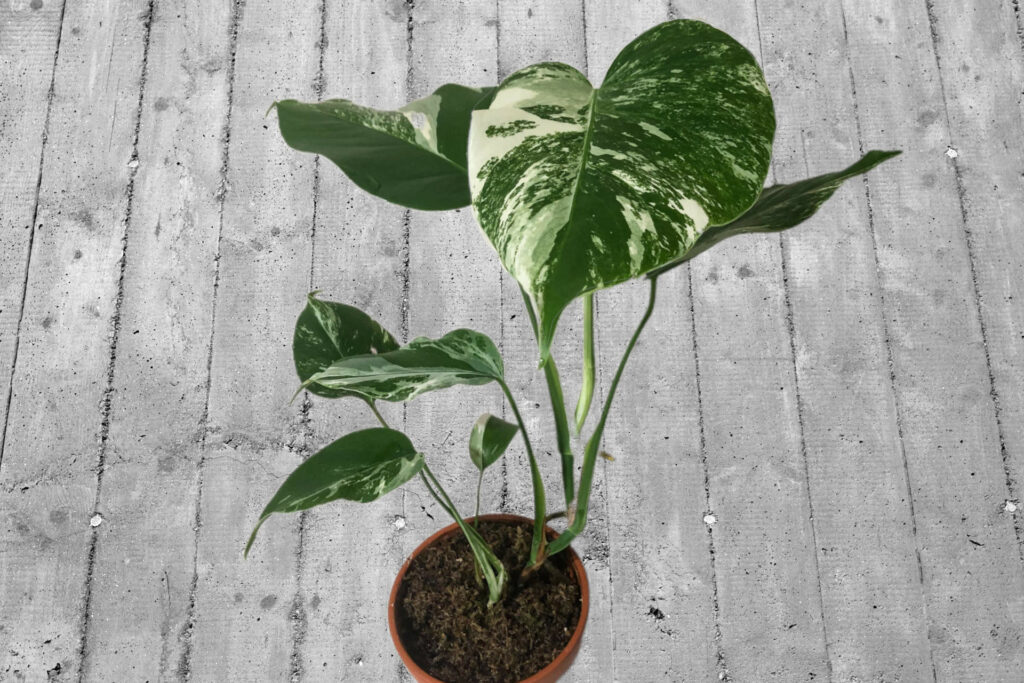
The Monstera Albo is a unique and striking plant that is sure to add a touch of elegance and sophistication to any interior design. While it may look similar to the Monstera deliciosa at first glance, in fact, it is a sub-species of the deliciosa, and there are a number of key differences between the two plants that set them apart.
One of the most notable differences between the Monstera Albo and the Monstera deliciosa is the coloration of their leaves. While the Monstera deliciosa has dark green leaves with distinctive holes and splits, the Monstera Albo has leaves that are a striking white-yellow color. it is the striking coloration that makes the Monstera Albo a popular choice for those looking to add a touch of color and interest to their home.
The best way to see the physical difference between albo and a deliciosa is by looking at the stem where it attaches to the leaf, where you will notice it lacks the ridges on the deliciosa.
Another key difference between the Monstera Albo and the Monstera deliciosa is their size and growth habit. While the Monstera deliciosa is larger, it is a slower-growing plant, and the Monstera Albo is smaller and more fast-growing. The albo's size makes it a great choice for those with limited space or those looking for a more manageable plant.
Propagation
Propagating a Monstera Albo is a relatively simple process that can be done through a number of different methods. The most popular method is to take stem cuttings from the plant and root them in water or a soil-less mix. Depending on the conditions, this process can take anywhere from a few weeks to a few months.
Another popular method of propagating the Monstera Albo is through air layering. This method involves making a small cut on the plant's stem and wrapping it in a moist medium such as sphagnum moss. Over time, roots will develop in the moss; once they are established, the stem can be cut away from the parent plant and planted in a container.
Light and Care
Regarding light and care, the Monstera Albo is a relatively low-maintenance plant. It prefers bright, indirect light and can tolerate a wide range of temperatures. However, it is important to keep the soil moist and avoid allowing the plant drying out.
In terms of feeding, it is recommended to give the Monstera Albo a balanced fertilizer every four to six weeks during the growing season. Additionally, giving the plant a good amount of humidity is important, as this will help keep the leaves looking lush and healthy.
Overall, the Monstera Albo is a beautiful and unique plant that is sure to add a touch of elegance and sophistication to any home. Its striking coloration and manageable size make it a great choice for those looking to add a touch of greenery to their home without the hassle of a larger and fast-growing plant.
#3 Monstera Adansonii
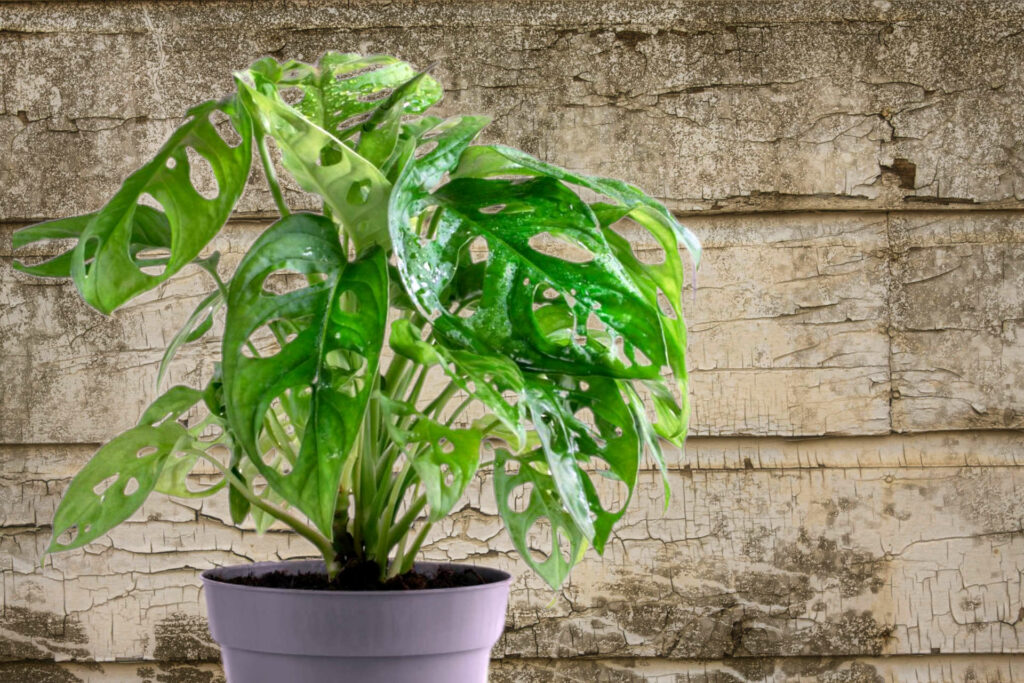
The Monstera Adansonii, " is an exceptional and breathtaking plant that can add a touch of elegance and sophistication to any interior design. Despite sharing similarities with the Monstera deliciosa and the Monstera Albo in terms of leaf shape and size, several distinctions distinguish it from these other plants.
One of the most remarkable distinctions between the Monstera Adansonii and other Monstera species is the scale and shape of its leaves. The leaves of the Monstera Adansonii are petite and more fragile than those of other Monstera species, and they possess a more lacy and fern-like appearance. Furthermore, its leaves can showcase a lighter green color than other Monstera species.
Another key distinction between the Monstera Adansonii and other Monstera species is its growth habit. Unlike the Monstera deliciosa and the Monstera Albo, which are large and fast-growing plants, the Monstera Adansonii is a smaller, more slow-growing plant. This makes it an ideal option for those with limited space or those looking for a more manageable plant.
Propagation
Propagating a Monstera Adansonii is a straightforward process that can be done through various methods. The most common method is to take stem cuttings from the plant and root them in water or a soil-less mix. Depending on the conditions, this process can take anywhere from a few weeks to a few months.
Another popular method of propagating the Monstera Adansonii is through air layering. This method involves making a small cut on the plant's stem and wrapping it in a moist medium such as sphagnum moss. Over time, roots will develop in the moss; once they are established, the stem can be cut away from the parent plant and planted in a container.
Light and Care
When it comes to the plant's needs in terms of light and care, the Monstera Adansonii is a low-maintenance plant. It prefers bright, indirect light and can tolerate a wide range of temperatures. It should be remembered that it is crucial to maintain the soil moistness and avoid allowing the plant to dry out.
Regarding feeding, it is recommended to give the Monstera Adansonii a balanced fertilizer every four to six weeks during the growing season. Additionally, it is important to provide the plant with a good amount of humidity, as this will aid in keeping the leaves looking lush and healthy.
Monstera Adansonii's Versatility
One of the great things about Monstera adansonii is its versatility. It can be grown as a climbing vine or trained to grow as a bush, making it a perfect option for various spaces. Its smaller leaves and less distinct fenestrations open up exciting design possibilities for those looking for a more subtle tropical touch in their home. Its trailing habit makes it the perfect choice for hanging baskets or trellises and can create a beautiful vertical garden.
In conclusion, Monstera adansonii is a visually striking and easy-to-care-for plant that can add a subtle tropical touch to any room. Its versatility and ease of propagation make it an excellent choice for both experienced and inexperienced plant owners. Whether you're looking to create a focal point in a room or add some greenery to a space, Monstera adansonii is sure to make a statement.
#4 Monstera Obliqua
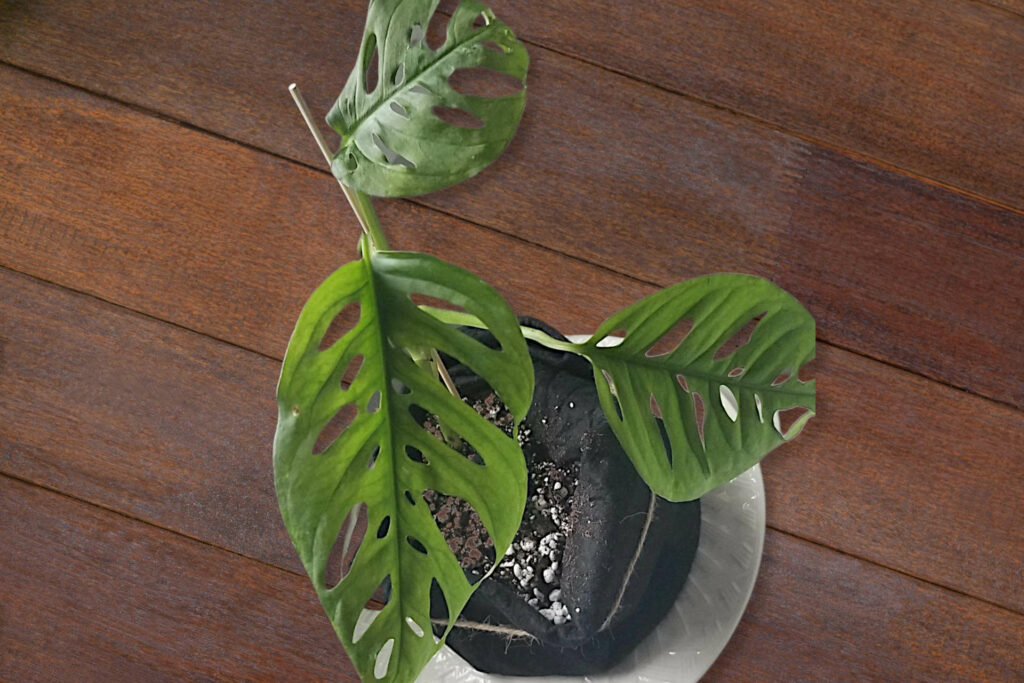
Monstera Obliqua, also known as the Windowleaf or Split-Leaf Philodendron, is a tropical plant known for its large, glossy, and deeply-lobed leaves. This plant can be grown as a climbing or trailing plant but has a slower growth rate than other Monstera varieties. Despite this, it is still popular for indoor gardening enthusiasts due to its unique and striking appearance.
Monstera Obliqua's Light Requirements
A Monstera Obliqua can grow in various light conditions, but it is important to note that lower light intensity can affect the leaf size and shape. While it can tolerate low light conditions, it will thrive in medium to bright indirect light. Direct sunlight can cause the leaves to turn yellow and the plant to become stunted. To ensure that your Monstera obliqua is getting the right amount of light, place it in a location where it will receive bright, indirect light for most of the day.
Monstera Obliqua's Watering Needs
The Monstera Obliqua, like other Monstera varieties prefers to be kept in consistently moist soil but not waterlogged. Overwatering can lead to root rot, so allowing the soil to dry out slightly between watering is essential. A good rule of thumb is to stick your finger into the soil; if it is dry to the touch, it's time to water.
Monstera Obliqua's Propagation
In terms of propagation, the Monstera Obliqua can also be propagated by taking stem cuttings and rooting them in water or soil, allowing you to create new plants from existing ones, which can be a great way to expand your collection or share with friends and family.
As with the adansonii and deliciosa, to propagate Monstera obliqua, take a stem cutting that includes at least one leaf node (the point on the stem where leaves grow) and a small section of stem. Remove any leaves from the bottom half of the cutting and place them in a jar or vase of water, ensuring that the leaf node is submerged.
Alternatively, you can place the cutting in a pot of soil and keep it moist until roots begin to form. Within a few weeks, roots will begin to grow, and new leaves will develop, indicating that the cutting has rooted and is ready to be transplanted into a larger pot.
In conclusion, Monstera obliqua is a beautiful and easy-to-care-for plant that can add a touch of tropical beauty to any room. Its unique leaf shape and size make it a striking addition to any space. Its versatility and ease of propagation make it a great option for both experienced and inexperienced plant owners. Despite its slower growth rate, it is still a great option for those who want to create a vertical garden or add a touch of greenery to a space.
#5 Monstera Siltepecana
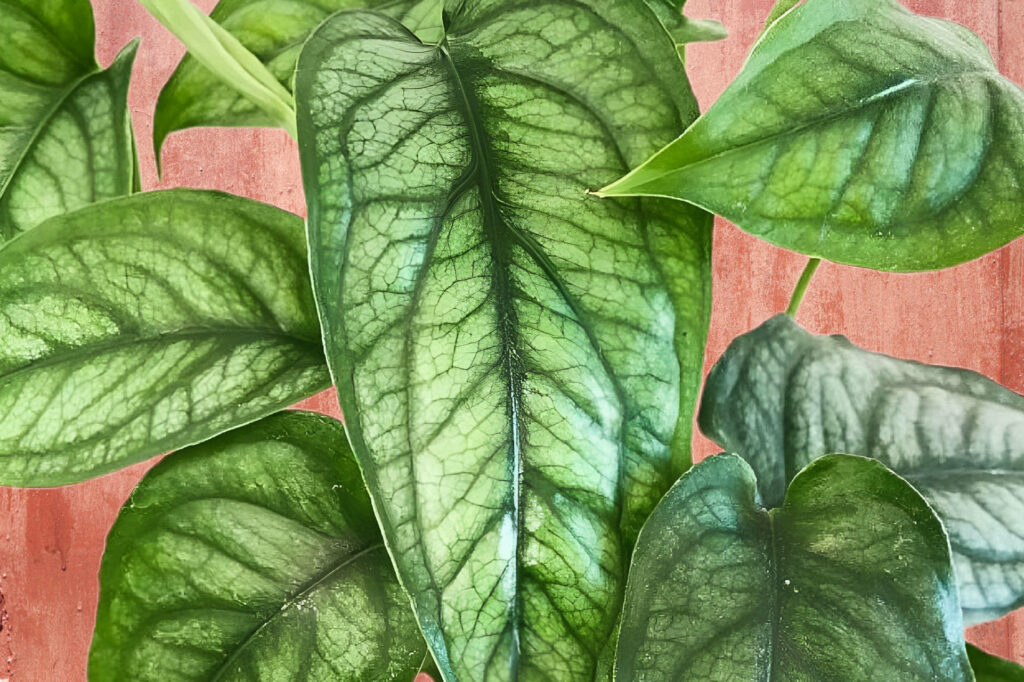
Monstera siltepecana is a rare and unique type of monstera species known for its small leaves with delicate holes and a white to silver variegation. This plant is known for its unique leaf pattern and small to medium size, making it a highly sought-after addition to any indoor garden.
Monstera Siltepecana's Growth Rate
Monstera siltepecana is known to be a slow grower, making it a great option for those who want a more delicate and unique-looking plant. This species is known for its small leaves with elegant holes and a white to silver variegation, making it a striking addition to any space. Despite its slower growth rate, it is still a popular option for indoor gardening enthusiasts due to its unique and distinctive appearance.
Monstera Siltepecana's Propagation
Monstera siltepecana can also be propagated by rooting stem cuttings in water or soil. This allows you to create new plants from existing ones, which can be a great way to expand your collection of plants.
To propagate Monstera siltepecana, simply take a stem cutting that includes at least one leaf node (the point on the stem where leaves grow) and a small section of stem. Remove any leaves from the bottom half of the cutting and place them in a jar or vase of water, ensuring that the leaf node is submerged. Alternatively, you can place the cutting in a pot of soil and keep it moist until roots begin to form. Within a few weeks, roots will begin to grow and new leaves will develop, indicating that the cutting has rooted and is ready to be transplanted into a larger pot.
Monstera Siltepecana's Light Requirements
Monstera siltepecana can grow in a variety of light conditions, but it is important to note that lower light intensity can affect the leaf size and shape. While it can tolerate low light conditions, it will thrive in medium to bright indirect light. Immediate, direct sunlight may result in the leaves yellowing and stunted growth. To ensure that your Monstera siltepecana is getting the right amount of light, place it in a location where it will receive bright, indirect light for most of the day.
To summarize, Monstera siltepecana is a rare and unique monstera species known for its small leaves with delicate holes and a white to silver variegation. It is a slow grower and requires tender care, but its unique leaf pattern and small to medium size make it a highly sought-after addition to any indoor garden.
#6 Monstera Borsigiana
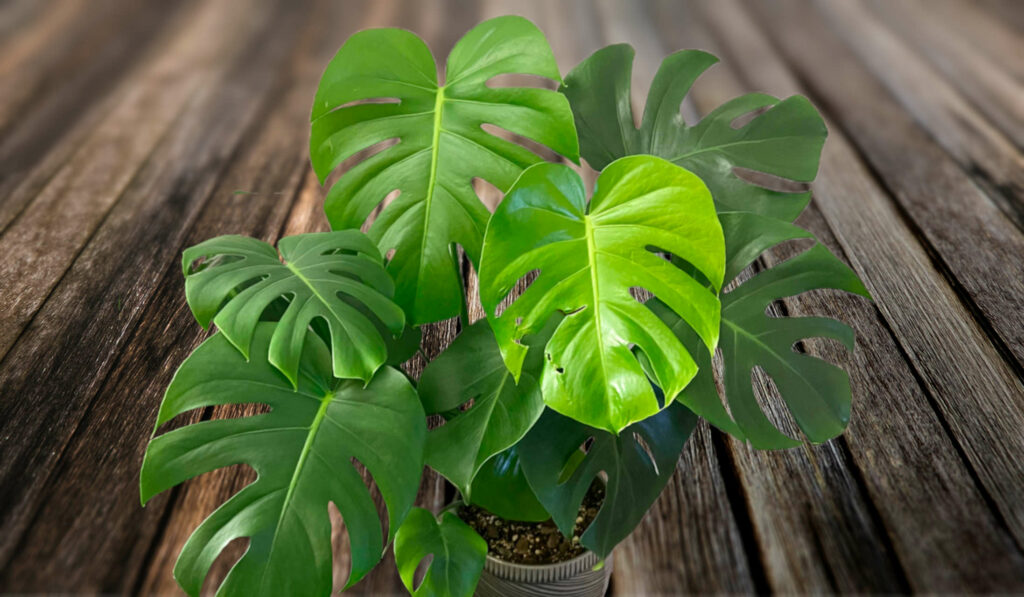
The final of our six Monstera varieties is the Monstera Borsigiana, also known as Dwarf Monstera. Like the albo, the Borsigiana is a subspecies of the Deliciosa and can often be confused with it when a young plant. Indeed Royal Botanic Gardens, Kew, in the UK, don't consider it as a separate species.
However there are differences. It is a smaller-sized monstera species with a compact growth habit. It has smaller leaves with less pronounced holes, giving it a more delicate appearance, distinctive fenestrations and green-white variegation in variegated plants. One tell tale sign is that on older plants a Deliciosa has ridge/ruffles on the stem just below the leaf. It is a fast grower and can be propagated by rooting stem cuttings in water or soil.
Monstera Borsigiana's Growth Habits
One of the key differences between Monstera Borsigiana and Monstera deliciosa is their growth habit. Monstera Borsigiana is a more compact plant and typically grows to be smaller than its cousin, making it a great choice for smaller spaces. It also tends to be more vigorous in its growth, making it a more manageable option for those with less experience with indoor gardening.
Monstera Borsigiana's Propagation
Just like other Monstera species, Monstera Borsigiana can be propagated by taking stem cuttings and rooting them in water or soil. Simply take a stem cutting that includes at least one leaf node and a small section of stem, remove any leaves from the bottom half, and place it in a jar or vase of water, ensuring that the leaf node is submerged.
Another option is to place the cutting in a pot of soil and keep it moist until roots begin to form. Within a few weeks, roots will begin to grow, and new leaves will develop, indicating that the cutting has rooted and is ready to be transplanted into a larger pot.
Monstera Borsigiana's Light Requirements
In terms of light and care, Monstera Borsigiana prefers bright, indirect light and well-draining soil. It is important to not over-water the plant, as this can lead to root rot. Allow the soil to dry out slightly between watering and make sure the plant has proper drainage. Additionally, it is important to regularly mist the leaves to give the plant enough humidity. To ensure that your Monstera Borsigiana is getting the right amount of light, place it in a location where it will receive bright, indirect light for most of the day.
Jess is a true horticulturist whose passion for plants has led her to become an expert in tropical houseplants. Jess was born and raised in South East Asia surrounded by lush jungles and lush botanical gardens. This environment prompted her to develop a love for all things green and growing. A move to the UK helped her plant care skills and improved her knowledge Her commitment to her craft and her dedication to her customers has earned her a reputation as one of the best in the business. She continues to inspire others with her love for nature and the environment.Bio Page
More Posts